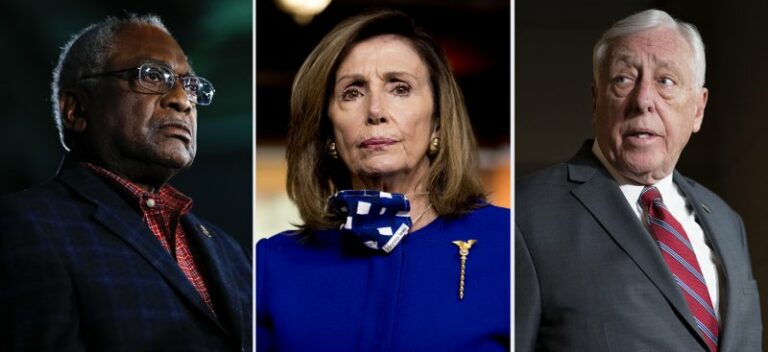House Democrats nominated Nancy Pelosi on Wednesday to be the speaker who guides them again next year as Joe Biden becomes president, and she quickly seemed to suggest these would be her final two years in the leadership post.
The California Democrat, the first woman to be speaker, was nominated by acclamation as the party’s lawmakers used a pandemic-induced virtual meeting to pick their leaders. Pelosi already has served six years in the job, but the next two loom as her toughest.
After unexpectedly losing at least 10 incumbents in this month’s elections, Democrats will have about a 222-213 majority, the tightest margin in two decades. That prospect has demoralized many Democrats and ignited blame-trading between moderates and progressives over why they flopped on Election Day.
In addition, Biden and Congress will confront an uncontrolled coronavirus pandemic, a virus-stifled economy and jagged divisions among voters who largely either idolize or detest outgoing President Donald Trump. And there’s anxiety already among Democrats looking ahead to 2022 and the midterm elections, which historically are punishing for the party that controls the White House.
Against that backdrop, many House Democrats have for years impatiently insisted it’s time for fresh leadership. Pelosi and her top two lieutenants, Steny Hoyer of Maryland and Jim Clyburn of South Carolina, have served in their positions together for over a dozen years and each is age 80 or older.
Pelosi called for unity when she addressed her colleagues Wednesday after winning the nomination. “The theme, I think, of what we do next has to be about justice” in the economy, health care and policing, she said, according to a transcript released by her office.
When a reporter asked Pelosi later whether the next two years would be her last as speaker, it was little surprise that she mentioned a commitment she made in 2018. Scrambling to win enough votes to become speaker, she said then that she would agree to limit her term to four more years.
“I can’t wait to be working with Joe Biden and preparing us for our transition into the future,” she said Wednesday. “So I don’t want to undermine any leverage I may have, but I made the statement.”
Biden’s office said the president-elect called Pelosi to congratulate her selection and spoke of working together “on a shared agenda to get COVID-19 under control and build our economy back better.”
All House members will pick the speaker when the new Congress convenes in early January. Hoyer was reelected majority leader and Clyburn as the No. 3 Democratic leader on Wednesday, party posts that need no House approval. Pelosi, Hoyer and Clyburn all won without opposition.
To become speaker again, Pelosi will need more votes than House Minority Leader Kevin McCarthy, R-Calif., who’s likely to garner nearly unanimous GOP support. That means Pelosi will need roughly 218 votes to prevail and can ill afford to lose more than a sprinkling of Democratic support.
Though she’s likely to succeed, it won’t be simple because when Pelosi was elected speaker in January 2019, 15 Democrats opposed her. Ten remain in Congress plus New York Rep. Anthony Brindisi, whose race remains uncalled, and New Jersey Rep. Jeff Van Drew, who became a Republican.
At least one former Pelosi opponent, Rep. Kurt Schrader, D-Ore., has already said he’s open to backing her as speaker this time. He said in an interview that he’s spoken to her about the need to rebrand Democrats as more moderate. “She may be the bulwark against the extreme far left,” he said.
In addition, there will be at least 15 first-term Democrats in the freshmen next year, and it was unclear how many will support Pelosi. Hinting that she won’t try leading Democrats again in 2022 may help her nail down the votes she needs.
One favorite to succeed her is New York Rep. Hakeem Jeffries, 50, a four-term Brooklyn lawmaker. His skills range from consensus building to launching stinging oratorical salvos at Trump, who he this week called the “hater in chief.”
Other Democrats eager to move up in leadership ranks include Reps. Katherine Clark of Massachusetts, David Cicilline of Rhode Island and Tony Cardenas of California. Jeffries and Clark were elected to top leadership posts on Wednesday, with Clark defeating Cicilline for the No. 4 job.
“The new ideas, the freshness that comes with that is important for the American people to see,” said Rep. Tim Ryan, D-Ohio, who’s unsuccessfully challenged Pelosi before but now says he’s a supporter. “And so yeah, I think she does another couple of years, allows everyone else to move up, I think is a good thing.”
It’s unclear whether Hoyer, a moderate, or Clyburn, Congress’ highest-ranking Black, would attempt to succeed Pelosi. Clyburn’s status within the party was supercharged this year when he revived Biden’s near-comatose bid for the Democratic presidential nomination in February by helping him win the South Carolina primary.
Pelosi came to Congress in 1987 and has led House Democrats, both as the minority and majority party, ever since 2003. When Democrats recaptured the majority in 2018 and she regained the speakership, she had early clashes with far left newcomers such as Rep. Alexandria Ocasio-Cortez, D-N.Y., but those were subsumed as the party pulled together to oust Trump.
Pelosi has won wide acclaim among Democrats as a leading Trump foe in battles over impeachment, immigration and health care. She’s given as good as she’s gotten from the insult-prone Republican president, sometimes directly to his face, prompting him to call her “Crazy Nancy” and supporters to create memes and action figures honoring her.
Pelosi has pushed bills through the House — before they died in the GOP-run Senate — embodying Democratic priorities such as overhauling ethics and campaign finance laws, lowering health care costs and rebuilding infrastructure. She’s also been a prodigious fundraiser for candidates.
(AP)











